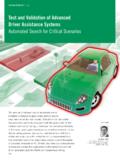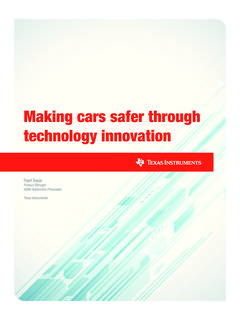Transcription of TI smart sensors enable automated driving - TI.com
1 TI's smart sensors ideal for automated driving applications Sneha Narnakaje Product Manager, Automotive Radar Radar Analytics and Processors Texas Instruments Introduction The automotive industry is driving innovation and technology advancements in robotics and machine vision. Automakers are designing new vehicles with a range of diverse technologies to keep up with ever-growing consumer demand. This trend has led to the introduction of the advanced driver assistance system ( adas ), which improves safety, comfort, convenience and energy efficiency. According to government agencies like the National Highway Traffic Safety Administration, more than 30,000 people in the United States and million people worldwide die in road crashes every year; about 94 percent of these crashes are related to human error.
2 An adas that helps with warning, breaking, monitoring and steering can assist drivers and potentially reduce errors. Many vehicles today boast features including blind-spot and lane-departure warning, forward collision and rear cross-traffic warning, automatic emergency breaking, lane-keep assist and adaptive cruise control. While these features differentiate brands and are revenue sources for automakers, several countries are now mandating that all vehicles must be equipped with adas by 2020. adas foundation of rely on leading semiconductor suppliers to provide automated driving automotive electronics ranging from advanced sensing technology and imaging/vision technology The demand for adas is growing rapidly, owing to high-performance and low-power processors and to a rising awareness of safety, an influence of in-car networking.
3 Regulations and original equipment manufacturer (OEM) safety ratings. According to the global adas The maturity and advancement of adas compo . market forecast from Research and Markets, nents will eventually enable semi-autonomous around 50 million vehicles equipped with adas and autonomous vehicles. Figure 1 on the were shipped in 2016; these shipments should following page summarizes the six levels of driving reach 60 million by 2022. Shipments of adas automation according to the definitions from components are expected to increase from 218 SAE International. million units in 2016 to billion units in 2025, An automated driving system is based on according to another adas market forecast many components, including sensors that from Research and Markets. A typical adas capture information about a car's surroundings, incorporates various sensing technologies along integrated circuits (ICs) for communication, high- with advanced processing and communication performance processors to analyze sensor data capabilities to automate, adapt and enhance vehicle and microcontrollers (MCUs) to activate and control systems for safety and better driving .
4 Automakers mechanical functions. TI's smart sensors ideal for automated driving applications 2 May 2017. Figure 1. Levels of automated driving No Driver Partial Conditional High Full Automation Assistance automation automation automation automation Airbag Adaptive cruise automated Autonomous Highly automated Autonomous driving ABS control parking parking driving Automatic emergency Lane keep assist Highway assist Stop & go (urban). braking Stop & go Blind spot warning (highway). Lane departure warning Park assist Figure 1. Levels of automated driving . Sensing systems are very critical to adas and simple vehicle control actions. While current LRR. automated driving since they add intelligence to systems use the 76 77 GHz frequency, as higher a vehicle, creating an accurate perception of the levels of automated driving require higher range surrounding environment.
5 Multiple image sensors in and resolution, front radar systems will likely use adas are becoming standard, but newer sensing both the 76 77 GHz and 77 81 GHz frequencies technologies such as radar, laser, ultrasonic, infrared for a combination of LRR and newer mid-range and lidar are all enhancing adas . radar (MRR) systems. Higher levels will require The automotive industry prefers radar sensors , radar sensors to analyze the complex scenarios since the sensor penetrates nonmetal objects by detecting hazards, measuring properties of the such as plastic, clothing and glass and is generally hazards (distance and velocity), and categorizing unaffected by environmental factors such as fog, them into objects with distinct properties (distance, rain, snow and bad or dazzling light. Automotive velocity, angle, height).
6 Finally, the sensors will need radar systems can be divided into short-, mid- and to assist with safe maneuvering. long-range radars, based on the range of object TI's AWR1x millimeter wave (mmWave) sensor detection; ultra-short range radar (USRR) is also portfolio helps developers to create a safer and Figure an emerging adas application 2. AWR1x for park-assist Block easier driving Diagram experience. Based on the mmWave systems. Driver-assist features such as blind spot sensing architecture (Figure 2), the AWR1x and lane-departure warning use short-range radar (SRR) systems. These systems, which fall under X. SAE International Level 1, are expected to report X. 4RX . ARM R4F C674x DSP. X. or warn drivers using light-emitting diodes (LEDs). X Up to or steering-wheel vibration. While current SRR MB RAM.
7 Systems use the 24 29 GHz frequency, according 3 TX. Calibration, to industry experts, that may well phase out in the . Monitoring Radar Synth Engine future because of regulations around output power Accelerator at lower frequencies. Connectivity and IO. Driver-assist features such as adaptive cruise CANFD CAN CSI SPI I2C. control and automatic emergency braking use long- range radar (LRR) systems. These systems take Figure 2. AWR1xx mmWave sensor block diagram. TI's smart sensors ideal for automated driving applications 3 May 2017. sensor integrates radio-frequency (RF) and analog controlled oscillator (VCO)-based chirp generation functionality with digital control capability into a and causes high chirp nonlinearities, resulting single chip. Using on-chip built-in self-test (BIST) in inaccurate range measurement.
8 The AWR1x capabilities can help automotive radar system mmWave sensor portfolio is also based on the developers to achieve functional safety compliance. FMCW technique. It uses a closed-loop PLL to In addition, the devices under this portfolio integrate enable percent linear and precise chirps, a customer-programmable MCU and radar resulting in improved range accuracy and higher signal-processing capabilities through a hardware range resolution. Chirp linearity avoids false accelerator or DSP. The radar sensor design can be detection and ghost objects artifact or secondary optimized by the level of integration in the AWR1x to image of an actual target. reduce size and power. Range resolution is a function of RF bandwidth. The AWR1x sensor portfolio supports up to 4-GHz Precise and ultra-high accuracy chirp bandwidth in a single sweep, enabling less to analyze complex, dense urban than a 5 cm range resolution, which is three times driving scenarios more accurate than mmWave solutions on the The automotive radar sensors use electromagnetic market today.
9 Waves in the 76 81 GHz frequency to determine Unambiguous velocity defines the ability to separate the range, velocity and angle of the objects in the objects with similar velocity. For a given range sensors ' field of view. While several parameters resolution and maximum range, a higher maximum define a radar system performance for range, velocity needs a higher IF bandwidth. The high- velocity and angle, resolution and accuracy are performance radar front end in the AWR1x portfolio two key parameters. Resolution defines the ability supports 15 MHz of IF bandwidth, enabling to separate two objects in range, velocity or angle, maximum ranges beyond 250 m and unambiguous while the other two variables are the same for those velocity up to 300 kph. The combination of IF. objects. For example, angular resolution defines the bandwidth and phase-noise performance enables ability to separate two vehicles driven at the same radar sensors to detect smaller objects in the speed and at the same distance from the radar vicinity of large objects.
10 Further, built-in 20-GHz sensor . Accuracy defines the accuracy of range synchronization capability for phase coherence or velocity or angle measurement of one object. in the high-performance front end enables you to For SAE International Level 2 and beyond, radar cascade multiple front ends to achieve <1-degree sensors need to have ultra-high accuracy for SRR. angular accuracy in dense urban driving situations applications (50 m). and better elevation estimation in drive-under Automotive radar systems often adopt the conditions such as overhead bridges and tunnels. frequency-modulated continuous waveform Putting it all together, in order to analyze the (FMCW) technique to measure the range, angle complex scenarios with highly automated driving , and velocity of remote objects. In FMCW radars, future radar sensors need to be highly accurate.
















